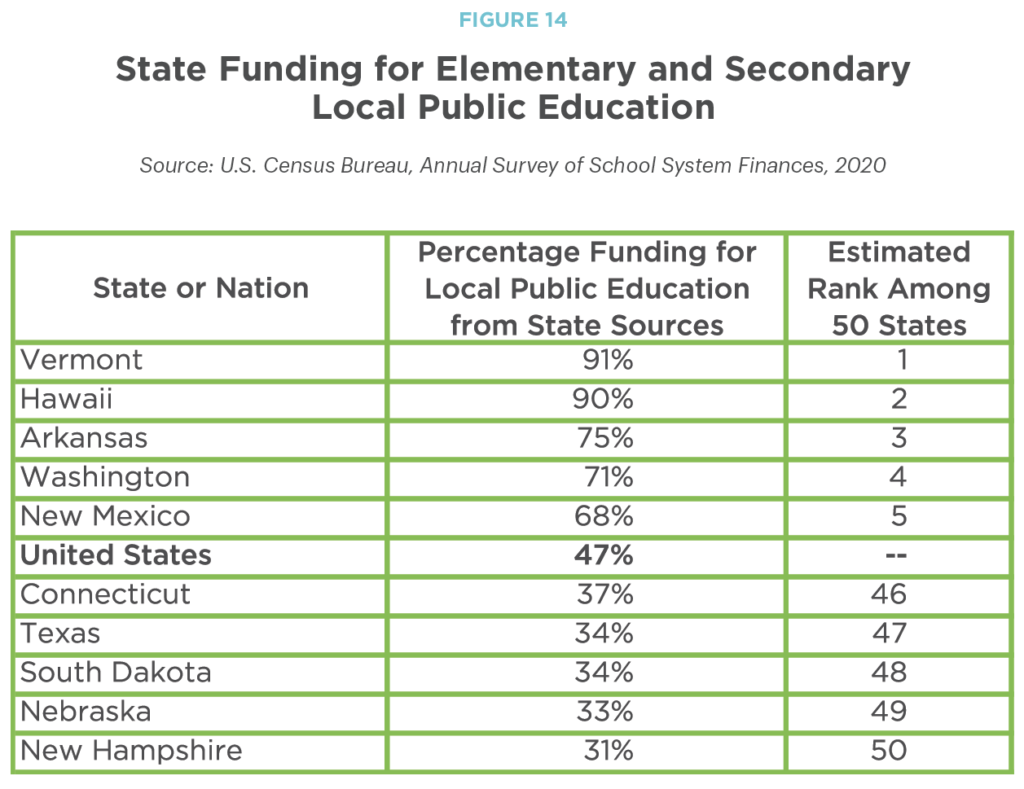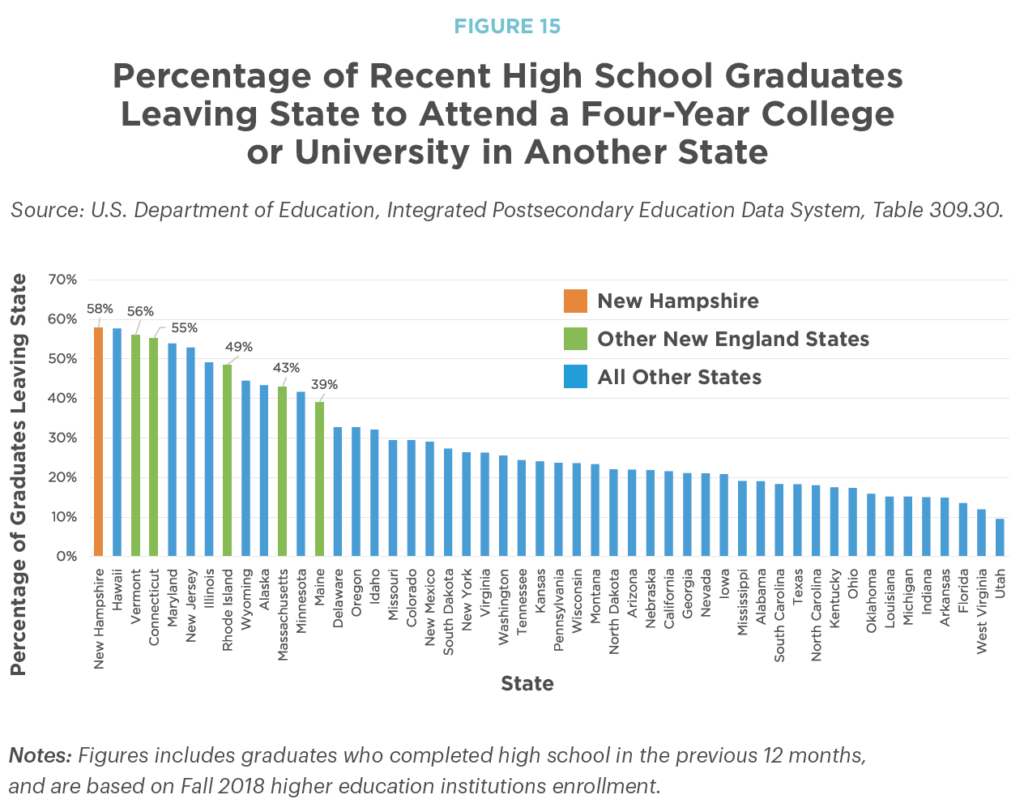This first edition of New Hampshire Policy Points provides an overview of the Granite State and the people who call New Hampshire home. It focuses on some of the issues that are most important to supporting thriving lives and livelihoods for New Hampshire’s residents.
New Hampshire Policy Points is intended to provide an informative and accessible resource to policymakers and the general public alike, highlighting areas of key concern. Touching on some important points but by no means comprehensive, each section within New Hampshire Policy Points includes the most up-to-date information available on each topic area as of October 2022.
The following section, Education, is one of nine sections that frame this resource guide. Other sections cover Population and Demographics, Income and Economic Security, Economy and Jobs, Housing, Health, Broadband Internet, Transportation, and How We Fund Public Services. The facts and figures included within this book provide useful information and references for anyone interested in learning about New Hampshire and contributing to making the Granite State a better place for everyone to call home.
To purchase a print copy or download a free digital PDF of New Hampshire Policy Points, visit nhfpi.org/policypoints
Education is a core public service and key to a strong democracy. Education supports social mobility, opening doors to greater access to job opportunities and helping build financial stability.
Higher levels of educational attainment are associated with higher levels of health and well-being later in life, including longer lifespans. Educational attainment is also correlated with lower levels of unemployment and poverty. Investing in education and training opportunities for a skilled and well-educated workforce is key to supporting both the individual lives of Granite Staters and the state economy overall.
New Hampshire’s population has a relatively high level of formal education. About 94 percent of Granite State residents over 25 years old held at least a high school diploma or equivalent in 2021, and approximately 40 percent had a bachelor’s degree or above. These figures are higher than the national averages. While New Hampshire’s high school graduation rate is similar to those of Vermont and Maine, the percentage of New Hampshire’s population holding a bachelor’s degree or above falls below that of Massachusetts, Vermont, and Connecticut. In New Hampshire, the median earnings of individuals age 25 and over increases with the level of formal education attained.
Early Childhood Education
Early childhood education plays a significant role in the development of children and in supporting working families. For children, investments in high-quality early childhood education and care can improve performance in school and reduce the likelihood of poverty later in life. For families, access to affordable and reliable child care means parents can pursue employment opportunities while trusting their children will be cared for and kept safe. Furthermore, investments in early childhood education benefit the economy. A RAND Corporation 31 analysis of preschool programs estimated a positive economic return of $2 for every dollar invested by the State of New Hampshire in a hypothetical high-quality, one-year preschool program. This return on investment is even higher for programs targeted at children from households with low incomes.
Prior to the pandemic, licensed child care capacity addressed only about 60 percent of the estimated need of children under the age of six in New Hampshire. By October 2020, about eight months into the pandemic, the Granite State’s formal capacity to meet child care needs fell to about 50 percent.
As the State does not provide funding for full-day preschool programs, the availability of affordable and accessible private child care is critical to working families and their ability to participate fully in the economy. National survey data show women, on average, perform more hours of child care duties per day than men. New Hampshire unemployment insurance program data indicate the initial impacts of the pandemic disproportionately led to more women losing their jobs at the start of the pandemic. Furthermore, New Hampshire survey data show declines in workforce participation during the pandemic were due in part to filling gaps in child care left by center and school closures.
K-12 Public Education
Local public education in New Hampshire is primarily administered by school districts covering individual cities and towns or encompassing collaborative efforts among multiple municipalities.
During the 2020–2021 school year, about 61 percent of school district funding for local public education was collected through local property taxes. Approximately 29 percent came through Adequate Education Aid from the State, including State property taxes raised and retained locally. Most Adequate Education Aid is allocated through grants on a per pupil basis. These grants depend on several factors, including the number of students who are English language learners, who have special education needs, and who live in households with low incomes. Federal grants provided about 7 percent of local school district revenue, while other State aid and other locally generated revenue comprised the rest.
Significant inequities in education funding exist across New Hampshire due to the heavy reliance on local property taxes to raise revenue. Since property valuations vary substantially between school districts, as does the number of students served, there are significant disparities in the resources available for, and invested in, each student across town and city borders. Greater support for education from the State could help alleviate these disparities. While New Hampshire had the 8th highest estimated total revenue per pupil among the 50 states, it ranked 35th in state revenue per pupil, and had the smallest percentage of local public education revenue coming from the state government. By directing more resources to districts with lower property values and students with lower incomes, the State could help address issues of education inequity and strengthen New Hampshire’s future workforce.
Higher Education
The Granite State is home to both public and private universities and colleges, as well as public community colleges, which provide a range of opportunities for higher education within the state. The University System of New Hampshire includes three institutions located on six campuses, while the Community College System of New Hampshire includes seven colleges over nine campuses.
New Hampshire provided the smallest amount of state and local funding, both relative to state population and to personal income, for public higher education of any state in the nation in fiscal year 2022. Both prior to and during the pandemic, New Hampshire increased investments into public higher education, but still lagged behind every other state.
Relative to other states, these low funding levels contribute to higher education costs for students, and factor into the disproportionately high debt load of many Granite State graduates. New Hampshire students face some of the nation’s highest in-state tuition rates for public universities and colleges. Average student debt in New Hampshire is the highest of all 50 states, with per-graduate debt for students who have any debt totaling nearly $40,000 per year for the Class of 2020.
These high costs may contribute to more high school graduates leaving the state for more affordable opportunities. In 2018, nearly 60% of New Hampshire high school graduates reported going out-of-state to attend a four-year college or university, which is the highest rate in the nation.
Continuing Education and Job Training
Beyond college or university, post-secondary education in New Hampshire can come in the forms of apprenticeships, nondegree certificates, and other training programs offered through both public and private institutions. Trade schools can help the Granite State fill critical shortages of workers among many key industries, including carpentry, plumbing, and electrical work. These trades provide many meaningful opportunities for students to pursue well-paying, stable careers and engage in the state economy.
Building a Strong Workforce
As New Hampshire seeks to bolster its economy and expand its workforce pipeline, greater investments in education, ranging from early childhood to higher education and other post-secondary opportunities, will be key to helping ensure broad access to opportunity and to building a vibrant and resilient economy.
High quality schools can serve as anchor institutions for communities and help attract new families and residents. As New Hampshire’s population grows older, the state’s future economic success depends on its ability to both attract and retain young people and to invest in the individuals and families already in New Hampshire. Expansions of educational opportunities, especially for Granite Staters who currently face difficulty accessing them, can help to build a more enriched and vibrant New Hampshire for everyone.
• • •
This publication and its conclusions are based on independent research and analysis conducted by NHFPI. Please email us at info@nhfpi.org with any inquiries or when using or citing New Hampshire Policy Points in any forthcoming publications.
© New Hampshire Fiscal Policy Institute, 2022.



